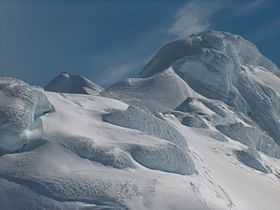Mount Friesland
| Mount Friesland | |
|---|---|
 | |
| Elevation | 1,700 m (5,577 ft)[1] |
| Prominence | 1,700 m (5,577 ft)[2] |
| Listing | Ultra |
| Location | |
 Mount Friesland | |
| Location | Livingston Island, South Shetland Islands, Antarctica |
| Range | Tangra Mountains |
| Coordinates | 62°40′14.9″S 60°11′10.7″W / 62.670806°S 60.186306°WCoordinates: 62°40′14.9″S 60°11′10.7″W / 62.670806°S 60.186306°W[1] |


| Wikimedia Commons has media related to Mount Friesland. |
Mount Friesland is a mountain in the Tangra Mountains of Livingston Island, in the South Shetland Islands. It is situated 12.5 kilometres (7.8 mi) northeast of Barnard Point, 9.7 kilometres (6.0 mi) east-southeast of St. Kliment Ohridski Base, 3.6 kilometres (2.2 mi) southeast of the summit of Pliska Ridge, 6.1 kilometres (3.8 mi) south by east of Mount Bowles, 2.9 kilometres (1.8 mi) south-southwest of Camp Academia, 7 kilometres (4.3 mi) west of Great Needle Peak, and 6.85 kilometres (4.26 mi) north by west of Samuel Point. The peak is heavily glaciated and crevassed.
The feature was known to American and British sealers as early as 1820–21, and has been variously known as "Peak of Frezeland", "Friezland Peak", and "Friesland Peak". In the early 1900s the name "Barnard", applied by James Weddell in 1825 to nearby Needle Peak, was transferred to this mountain. The original name has now been restored; the spelling "Friesland" appears to have been more frequently used than any of the other versions. The name Barnard Point has since been approved for the nearby point at the southeast side of False Bay.[3][4]
The first ascent of Mount Friesland was made from Juan Carlos I Base on 30 December 1991 by the Catalan climbers Francesc Sàbat and Jorge Enrique, after whom Sàbat Hill and Enrique Hill, respectively, were named. The peak was climbed and GPS surveyed by the Australians Damien Gildea and John Bath and the Chilean Rodrigo Fica on 20 December 2003; they produced a new map of the island in 2004, based on Spanish satellite imagery and their GPS data. The third ascent was made by the Bulgarians Lyubomir Ivanov and Doychin Vasilev from Camp Academia on 15 December 2004. All these used the eastern route to the peak, by way of Catalunyan Saddle and Presian Ridge.
Maps
- S. Soccol, D. Gildea and J. Bath. Livingston Island, Antarctica. Scale 1:100000 satellite map. The Omega Foundation, USA, 2004.
- L.L. Ivanov et al., Antarctica: Livingston Island and Greenwich Island, South Shetland Islands (from English Strait to Morton Strait, with illustrations and ice-cover distribution), 1:100000 scale topographic map, Antarctic Place-names Commission of Bulgaria, Sofia, 2005
- L.L. Ivanov. Antarctica: Livingston Island and Greenwich, Robert, Snow and Smith Islands. Scale 1:120000 topographic map. Troyan: Manfred Wörner Foundation, 2009. ISBN 978-954-92032-6-4
See also
References
- ↑ 1.0 1.1 Expedition Omega Livingston 2003.
- ↑ "Antarctica Ultra-Prominences" Peaklist.org. Retrieved 2012-09-06.
- ↑ "Friesland, Mount". Geographic Names Information System, U.S. Geological Survey. Retrieved 2012-04-10.
- ↑ Mount Friesland. SCAR Composite Antarctic Gazetteer.
External links
![]() This article incorporates public domain material from the United States Geological Survey document "Friesland, Mount" (content from the Geographic Names Information System).
This article incorporates public domain material from the United States Geological Survey document "Friesland, Mount" (content from the Geographic Names Information System).